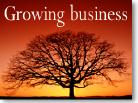|
Expanding a start-up, pt.1
|
 |
February 6, 1998: 4:05 p.m. ET
Business owners can grow successfully by focusing on what they know
|
NEW YORK (CNNfn) - Nancy Benton and her husband "walked a fine line between courage and foolhardiness" the first time they expanded their candle-making business.
"It was a big gamble," she said of the first time they took Creative Candles from a closet operation through its first growth phase in Kansas City, Mo., in the early 1960s. "We were pretty ignorant. We didn't really know what our market was at that time, or what it would take [to succeed]."
Small business owners today can't afford to be ignorant about potential risks an expansion project might carry. An expanded operation could boost the business. But extra debt not offset by increased profits could bring the business down.
In this first of a two-part series, CNNfn takes a look at how to expand a business successfully - and avoid pitfalls in the process.
The need to expand may not always be obvious, says Marilynn Force, director of the Small Business Development Center in Boulder, Colo. "A lot of times, companies will realize abruptly that they need to expand when they hit a level of sales and can't go any higher. …You've got to have some ability to expand if you want to serve any more people."
Knowing the terrain
Force and other experts say your expansion stands a good chance of success if you have solid expertise in the field you're expanding in and your existing business is profitable.
"We have built ourselves a record," Kathleen Smith said of the successful lodging business she and husband Noel started in Saratoga Springs, N.Y., 30 years ago.
The couple owns a hotel and a bed-and-breakfast. They have just bought two old buildings side-by-side in the heart of downtown and plan to turn them into one luxury hotel.
Smith said the banks supported this latest venture for several reasons. The couple is highly skilled in the lodging/hospitality business. What's more, the Saratoga area's horse racing and other attractions draw throngs of wealthy visitors able to afford concierge-level accommodations.
"In the area we live in, it's much easier to sell a high-end room than it is a budget room," Smith said. "Saratoga at this point does not have a four-diamond property, and I know there's a spot here for one. I'm giving that kind of service right now at my bed and breakfast; now I want to start charging people for it."
Taking out additional loans
Many business owners say a loan for an expansion was a lot easier to get than the first business startup loan. That's because they already had established a good relationship with a bank.
"With an existing customer, we're pretty well keyed into most of the information [needed]," said Paul Ryan, vice president at Albank FSB, which handles commercial loans for several upstate New York communities.
But an expansion loan brings its own set of questions. In addition to financial statements, Ryan said, bankers want information on the business history, the products and industry, and the competition.
"We'd also like some information on the management team of that business. We'd like to know their background," he said. "Is this a new market for them?"
Banks get uneasy about a business owner expanding into unfamiliar territory, Ryan said. An example would be a greasy-spoon diner that starts serving fancy linen-napkin dinners. The owner might build a mean BLT, but can he marinate a filet mignon with equal finesse? Can his head waitress pop champagne corks as adeptly as she plunks down blue-plate specials?
"If a company is moving into a new product line, or if it's in an area where they have not developed an expertise, there's increased risk there," Ryan said. "We'd need to talk more about what they are planning to do as a result of the expansion, and what benefit it is to the company."
How much debt?
How much debt is too much when considering a business expansion? If you're paying off existing loans in a timely fashion, banks are willing to lend you more -- up to a point.
"You can't have more than a 5-1 debt-to- total-net-worth ratio," said the Small Business Development Center's Force. If a $1 million company were to assume debts exceeding $5 million, "[banks] feel that the company will be way too leveraged to survive any financial challenges."
Ryan said banks don't want a borrower relying on the success of the expansion to pay back the loan.
"If a company [in its present state] has enough cash flow to repay its existing loans plus a good portion of what they're proposing to take on, the risk is much less than if you're dependent on the expansion to pay back the loan," he said.
Smith said she learned a lot about her financial standing when she wrote up her business plan for this latest venture.
"That's a great education," she said. "It helps you answer all the right questions: Can I make any money doing this? Can I pay my bills doing this?
"That's critically important," she said. "You have to be making money."
-- by Margaret Nowak for CNNfn Interactive
|
|
|
|
|
 |

|

